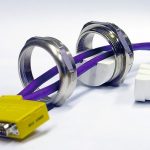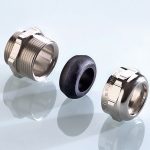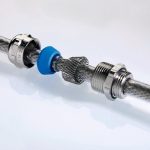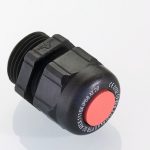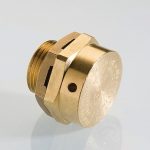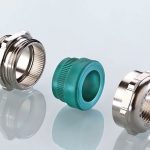There can be hardly any other field relevant to safety that has generated so much drafting and redrafting of standards as Ex (explosion) protection. Every year sees more changes to existing regulations to ensure that only systems which are truly explosion-proof are placed on the market. This is no simple matter for manufacturers, as the example of cable glands demonstrates.
Cable glands certified according to the latest Atex requirements
Certainly not explosive
There can be hardly any other field relevant to safety that has generated so much drafting and redrafting of standards as Ex (explosion) protection. Every year sees more changes to existing regulations to ensure that only systems which are truly explosion-proof are placed on the market. This is no simple matter for manufacturers, as the example of cable glands demonstrates.
EU standards are constantly being updated to take new requirements into account. For manufacturers, this means the affected products have to be recertified time and time again and any necessary modifications implemented.
All devices, protective systems and components for use in potentially explosive atmospheres must comply with the relevant EU directive (94/9/EC). In technical literature, this directive is sometimes referred to as Atex 95 or the Atex Equipment Directive. The term Atex (Atmosphères Explosibles) has been adopted in EC type examination certificates, which are issued based on the provisions of this EU directive. The new EU directive 2014/34/EU has applied since April 2014. EC type examination certificates complying with the directive have only been issued since this date.
The 94/9/EC directive sets out the requirements for equipment, safety systems and components for use in potentially explosive atmospheres. It contains the basic safety requirements and applies to the design, construction and production phases of explosion-protected equipment. This equipment is also subject to special monitoring during manufacturing in accordance with DIN EN ISO/IEC 80079-34 to ensure “good” and appropriate manufacturing practices. The Atex Directive is mandatory for all member states of the European Union (EU).
The 94/9/EC directive governs product approv-al and conformity procedures comprised of the EC type examination, quality monitoring, the manufacturer or supplier’s EC declaration of conformity and the CE marking. An EC type examination is required for all equipment and protective systems intended for use in potentially explosive atmospheres (zones 0 and 1 = explosive due to the presence of gases as well as zones 20 and 21 = explosive due to the presence of dusts). A manufacturer’s declaration is sufficient only for class II 3G and 3D equipment or protective systems for use in Zones 2 and 22.
In order for an EC type examination certificate to be granted, the manufacturer or supplier must have an accredited quality assurance system, certified in accordance with the ISO 9001 series of standards, in place for the production process. This QA system must include the performance of an additional audit covering the special requirements relating to Ex equipment. Furthermore, all Pflitsch Ex versions undergo a special quality assurance process.
No explosion from sparking
Only components certified in accordance with Atex may be used in potentially explosive atmospheres. Gases and dusts are prevented from entering the housings and systems of such components, so that an explosion cannot occur in potentially explosive atmospheres as a result of sparking. Cable glands are therefore very important in this situation, because they have to securely “close” the holes in the housings through which the cables pass. In the lat-est versions of the EN 60079-0, EN 60079-7 and EN 60079-31 standards for cable glands, Ex versions in the installed state must “prove” that they remain reliably sealed even when they age – i .e. after a long operating life in a piece of plant or machinery – and that they continue to provide at least an IP 54 standard of seal as well as specific levels of strain relief. The relevant allowable operating temperature is -20 to +60 °C.
For the manufacturer, this means that all products must undergo the complex certification procedure which the German manufacturer Pflitsch recently completed for its UNI Dicht and blueglobe series in metal.
Three application-oriented series
Pflitsch cable glands are currently approved in accordance with this procedure for G (gas) and D (dust) applications in equipment class II as well as in the e (increased safety for zones 1, 2, 21 and 22) and d (flameproof) types of protection. For the Ex e type of protection, the UNI Dicht system includes metal (brass or stainless steel) Ex cable glands in sizes M10 to M80 or Pg 7 to Pg 48 that achieve IP 68 and are approved for temperatures from -20 to +60 °C.
The blueglobe series in nickel-plated brass or stainless steel and sizes M12 to M85 is also certified according to Atex: its TPE sealing insert is likewise approved for temperatures from -20 to +60 °C while the silicone HT insert can cope with anything from -55 to +160 °C. IP 68 protection is achieved.
The manufacturer offers a series of metal (brass or stainless steel) Ex cable glands for the Ex d type of protection in sizes M16 to M100, or on request with Pg, imperial or NPT connection threads, for armoured and non-armoured cables and wires. The UNI Dicht 2M series is designed for applications involving large numbers of cable glands where high standards of seal and strain relief are called for alongside durability. The main focus during the development of this product was on providing very large sealing ranges, i. e. one cable gland size seals cables of any thickness. In addition, the materials used for the gland bodies and sealing inserts were optimised. The resulting combination of shorter installed depths and small wrench sizes with closer hole centres produces highly compact installations.
UNI Dicht 2M in high-quality nickel-plated brass is initially available in four common sizes from M16 to M40 for cable diameters from 4 to 33.5 mm. In response to demand, an M50 size for even larger cable cross-sections is in preparation. The green TPE sealing insert sits in such a way that it cannot turn in the double nipple and provides a reliable but gentle seal. UNI Dicht 2M has been tested to the latest version of EN 60079.
In addition to Atex Ex-d and Ex-e, these cable glands are also approved in accordance with IECEx and EAC.
Sealing inserts replace Ex sealing plugs
Ex cable glands with solid sealing inserts are used to effectively seal unoccupied holes in housings with Ex e explosion protection. They allow users the option of simply replacing the sealing insert if one or more wires or cables have to be fed into the housing at a later date. A separate Ex sealing plug, which would normally be employed instead of a cable gland, is no longer necessary.
Since the protection demanded of housings is increasing, it is essential today that the air inside them can circulate. Pflitsch’s solution for this is a vent connection for the Ex e type of protection, which can simply be screwed into a hole in the housing.
Optimum safety: Ex and EMC protection
The various Atex-certified EMC cable glands are particularly worthy of mention: they provide explosion protection in combination with efficient EMC safety. The 360° contact with the cable shielding braid via a surrounding spring allows the UNI Iris, UNI HF, UNI EMC Dicht with double cone and Iris spring, and blue-globe TRI with triangular spring to achieve very high shielding values, which are higher than those specified in the standard right up into the GHz range. Electromagnetic interference is effectively kept away from the system electronics. In addition, these glands could not be simpler to install: the cable sheath only needs to be removed from the spring contact point. The shielding braid remains intact and complete right up to the terminal in the housing. Certified solutions are also available for steel-reinforced cables. As with the UNI Dicht modular system, Pflitsch offers a number of application-specific solutions, e. g. with pres-sure screws for fixed or flexible cable layouts where special strain relief requirements apply, or with expanders or reducers to guide thick or thin cables securely through a given hole size. Many products can be connected to protective tubing to provide mechanical protection for the cable.
Hall 13, Booth E99
www.cpp-net.com search: cpp0116pflitsch
Walter Lutz
Walter Lutz
Specialised journalist
Share:



